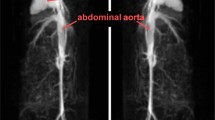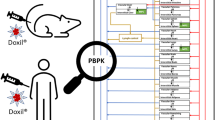Abstract
The influence of magnetic albumin microspheres on the disposition of adriamycin was evaluated. Adriamycin concentrations were monitored in multiple rat tissues for 48 hr after its intra-arterial administration (2 mg/kg) as a solution and associated with magnetic albumin microspheres. The magnetic dosage form was targeted to a predefined tail segment with a magnetic field strength of 8000 G applied for 30 min after dosing. A physiological pharmacokinetic model was used to describe the disposition of adriamycin following its administration from either dosage fcrm. The model developed for the data resulting from administration of adriamycin as a solution served as a foundation for the model developed for adriamycin resulting from the administration of adriamycin associated with the magnetic dosage form. The model for adriamycin following administration of the magnetic microspheres required additional relationships to describe the transport of adriamycin associated with the microspheres. For both models, the predicted adriamycin concentrations were in adequate agreement with the observed values. The present investigation demonstrates the use of a physiological pharmacokinetic modeling method to represent drug kinetics following its administration via a targeted drug delivery system.
Similar content being viewed by others
References
H. Sezaki and M. Hashida. Macromolecule-drug conjugates in targeted cancer chemotherapy.CRC Crit. Rev. Ther. Drug Carrier Sys. 1:1–38 (1984).
K. K. Chan, J. L. Cohen, J. F. Gross, K. J. Himmelstein, J. R. Bateman, Y. Tsu-Lee, and A. S. Marlis. Prediction of adriamycin disposition in cancer patients using a physiological pharmacokinetic model.Cancer Treat. Rep. 62:1161–1171 (1978).
Y. Igari, Y. Sugiyama, Y. Sawada, T. Iga, and M. Hanano. Prediction of diazepam disposition in the rat and man by a physiological based pharmacokinetic model.J. Pharmacokin. Biopharm. 11:577–593 (1983).
K. Widder, G. Flouret, and A. Senyei. Magnetic microspheres: Synthesis of a novel parenteral drug carrier.J. Pharm. Sci. 68:79–82 (1979).
K. J. Widder, A. E. Senyei, and D. G. Scarpelli. Magnetic microspheres: A model system for site specific drug delivery in vivo.Proc. Soc. Exp. Biol. Med. 58:141–146 (1978).
K. J. Widder, R. M. Morris, G. Poore, D. P. Howard, Jr., and A. E. Senyei. Tumor regression in Yoshida sarcoma-bearing rats by selective targeting of magnetic albumin microspheres containing doxorubicin.Proc. Nat. Acad. Sci. US. 78:579–581 (1981).
K. Sugibayashi, M. Okumura, and Y. Morimoto. Biomedical applications of magnetic fluids III. Antitumor effect of magnetic albumin microsphere-entrapped adriamycin on lung metastasis of AH 7974 in rats.Biomaterials 3:181–186 (1982).
P. K. Gupta, C. T. Hung, F. C. Lam, and D. G. Perrier. Albumin Microspheres III. Synthesis and characterization of microspheres containing adriamycin and magnetite.Int. J. Pharmaceut. 43:167–177 (1988).
J. M. Gallo, C. T. Hung, and D. G. Perrier. Reversed-phase ion-pairing HPLC of adriamycin and adriamycinol in rat serum and tissues.J. Pharmaceut. Biomed. Anal. 4:483–490 (1986).
K. B. Bischoff and R. G. Brown. Drug distribution in mammals.Chem. Eng. Progr. Symp. 62:33–45 (1966).
Y. Sasaki and H. N. Wagner, Jr. Measurement of the distribution of cardiac output in unanesthetized rats.J. Appl. Physiol. 30:879–884 (1971).
A. Tsuji, E. Miyamoto, T. Terasaki, and T. Yamana. Physiological pharmacokinetics of beta-lactam antibiotics: Penicillin V distribution and elimination after intravenous administration in rats.J. Pharm. Pharmacol. 31:116–119 (1979).
L. A. Sapirstein, E. H. Sapirstein, and A. Bredemeyer. Effect of hemorrhage on the cardiac output and its distribution in the rat.Circ. Res. 8:135–148 (1960).
J. M. Gallo, F. C. Lam, and D. G. Perrier. Area method for the estimation of partition coefficients for physiological pharmacokinetic models.J. Pharmacokin. Biopharm. 15:271–280 (1987).
J. M. Gallo, F. C. Lam, and D. G. Perrier. Moment method for the estimation of mass transfer coefficients for physiological pharmacokinetic models. Submitted for publication.
T. Terasaki, T. Iga, Y. Sugiyama, and M. Hanano. Experimental evidence of characteristic tissue distribution of adriamycin. Tissue DNA concentration as a determinant.J. Pharm. Pharmacol. 34:597–600 (1982).
M. L. Rocci and W. J. Jusko. LAGRAN program for area and moments in pharmacokinetic analysis.Comp. Prog. Biomed. 16: 203–216 (1983).
R. L. Dedrick and K. B. Bischoff. Pharmacokinetics in applications of the artificial kidney.Chem. Eng. Progr. Symp. 64:32–44 (1968).
C. N. Chen and J. C. Andrade. Pharmacokinetic model for simultaneous determination of drug levels in organs and tissues.J. Pharm. Sci. 65:717–724 (1976).
Advanced Continuous Simulation Language (ACSL), Mitchell and Gauthier Associates, Concord, MA.
J. G. Townsend. Physiologically based pharmacokinetics of anti-cancer drugs and toxic substances-application to adriamycin and ethylene glycol. Master's thesis, Carnegie-Mellon University, April 1980.
L. E. Gerlowski. Physiologically based pharmacokinetics of anti-cancer agents and trace metals-adriamycin, zinc and calcium. Master's thesis, Carnegie-Mellon University, May 1982.
H. J. Peters, G. R. Gordon, D. Kashiwase, and E. M. Action. Tissue distribution of doxorubicin and doxorubicinol in rats receiving multiple doses of doxorubicin.Cancer Chemother. Pharmacol. 7:65–69 (1981).
K. J. Widder, P. A. Marino, R. M. Morris, D. P. Howard, G. A. Poore, and A. E. Senyei. Selective targeting of magnetic albumin microspheres to the Yoshida sarcoma: Ultrastructural evaluation of microsphere disposition.Eur. J. Cancer Clin. Oncol. 19:141–147 (1983).
K. J. Widder, A. E. Senyei, and D. F. Ranney. Magnetically responsive microspheres and other carriers for the biophysical targeting to antitumor agents. In S. Garattini, A. Goldin, F. Howking, J. Kopin, and R. J. Schnitzer (eds.),Advances in Pharmacology and Chemotherapy, Academic Press, NY, 1979, p. 213–271.
Author information
Authors and Affiliations
Additional information
Research support from the Medical Research Council of New Zealand is gratefully acknowledged.
Rights and permissions
About this article
Cite this article
Gallo, J.M., Hung, C.T., Gupta, P.K. et al. Physiological pharmacokinetie model of adriamycin delivered via magnetic albumin microspheres in the rat. Journal of Pharmacokinetics and Biopharmaceutics 17, 305–326 (1989). https://doi.org/10.1007/BF01061899
Received:
Revised:
Published:
Issue Date:
DOI: https://doi.org/10.1007/BF01061899




